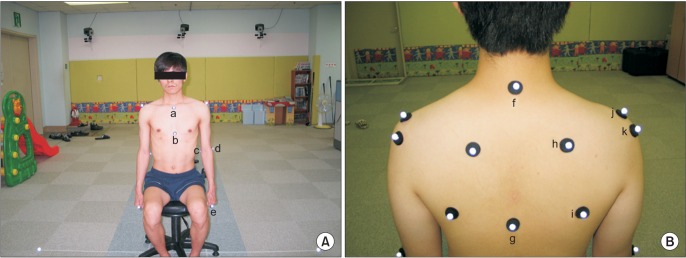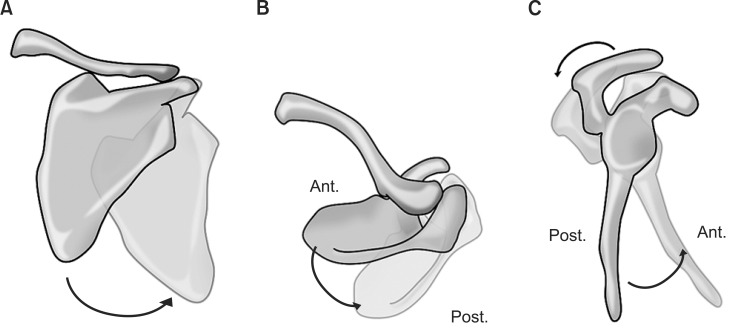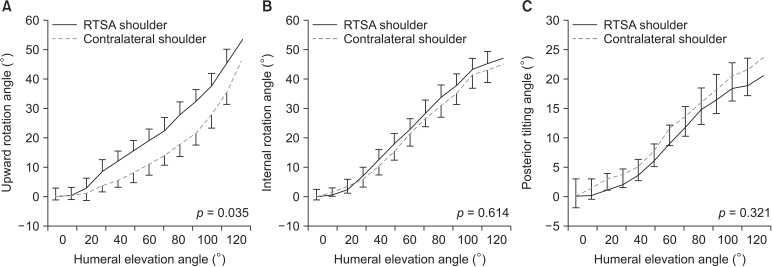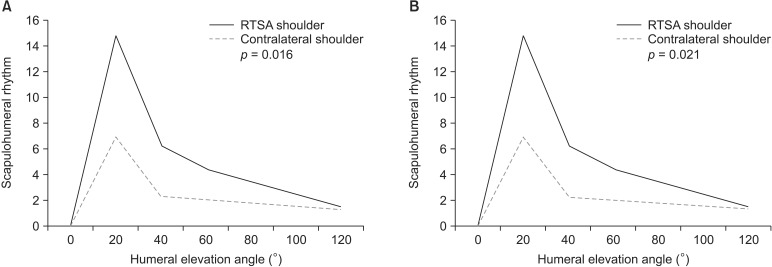Clin Orthop Surg.
2016 Sep;8(3):316-324. 10.4055/cios.2016.8.3.316.
Three-Dimensional Scapular Kinematics in Patients with Reverse Total Shoulder Arthroplasty during Arm Motion
- Affiliations
-
- 1Department of Orthopedic Surgery, Eulji University School of Medicine, Daejeon, Korea.
- 2Department of Orthopedic Surgery, Sewoori Hospital, Daejeon, Korea. gtdrin@hanmail.net
- KMID: 2374279
- DOI: http://doi.org/10.4055/cios.2016.8.3.316
Abstract
- BACKGROUND
There have been few reports on altered kinematics of the shoulder after reverse total shoulder arthroplasty (RTSA). We investigated differences in 3-dimensional (3D) scapular motions assessed using an optical tracking system between RTSA treated shoulders and asymptomatic contralateral shoulders during arm motion.
METHODS
Thirteen patients who underwent RTSA were assessed for active arm elevation in 2 distinct elevation planes (sagittal plane flexion and scapular plane abduction). Their mean age was 72 years (range, 69 to 79 years) and the mean follow-up was 24.4 months (range, 13 to 48 months). The dominant side was the right side in all the 13 patients, and it was also the side treated with RTSA. Scapular kinematics was recorded with an optical tracking system. The scapular kinematics and the scapulohumeral rhythm (SHR) of the RTSA shoulders and asymptomatic contralateral shoulders were recorded and analyzed during arm elevation.
RESULTS
There were no significant differences in internal/external rotation and anterior/posterior tilting of the scapula between shoulders during arm motion (p > 0.05). However, upward rotation of the scapula differed significantly during arm motion (p = 0.035 for sagittal plane flexion; p = 0.046 for scapular plane abduction). There were significant differences in the SHR between the two shoulders (p = 0.016 for sagittal plane flexion; p = 0.021 for scapular plane abduction).
CONCLUSIONS
The shoulder kinematics after RTSA showed significant differences from the contralateral asymptomatic shoulders. Increased upward rotation and decreased SHR after RTSA indicate that RTSA shoulders use more scapulothoracic motion and less glenohumeral motion to elevate the arm.
Keyword
MeSH Terms
Figure
Reference
-
1. Neer CS 2nd, Craig EV, Fukuda H. Cuff-tear arthropathy. J Bone Joint Surg Am. 1983; 65(9):1232–1244. PMID: 6654936.
Article2. Sirveaux F, Favard L, Oudet D, Huquet D, Walch G, Mole D. Grammont inverted total shoulder arthroplasty in the treatment of glenohumeral osteoarthritis with massive rupture of the cuff: results of a multicentre study of 80 shoulders. J Bone Joint Surg Br. 2004; 86(3):388–395. PMID: 15125127.3. Werner CM, Steinmann PA, Gilbart M, Gerber C. Treatment of painful pseudoparesis due to irreparable rotator cuff dysfunction with the Delta III reverse-ball-and-socket total shoulder prosthesis. J Bone Joint Surg Am. 2005; 87(7):1476–1486. PMID: 15995114.
Article4. Frankle M, Siegal S, Pupello D, Saleem A, Mighell M, Vasey M. The reverse shoulder prosthesis for glenohumeral arthritis associated with severe rotator cuff deficiency: a minimum two-year follow-up study of sixty patients. J Bone Joint Surg Am. 2005; 87(8):1697–1705. PMID: 16085607.5. Guery J, Favard L, Sirveaux F, Oudet D, Mole D, Walch G. Reverse total shoulder arthroplasty: survivorship analysis of eighty replacements followed for five to ten years. J Bone Joint Surg Am. 2006; 88(8):1742–1747. PMID: 16882896.6. Boileau P, Watkinson D, Hatzidakis AM, Hovorka I. Neer Award 2005: the Grammont reverse shoulder prosthesis: results in cuff tear arthritis, fracture sequelae, and revision arthroplasty. J Shoulder Elbow Surg. 2006; 15(5):527–540. PMID: 16979046.
Article7. Cuff D, Pupello D, Virani N, Levy J, Frankle M. Reverse shoulder arthroplasty for the treatment of rotator cuff deficiency. J Bone Joint Surg Am. 2008; 90(6):1244–1251. PMID: 18519317.
Article8. Bufquin T, Hersan A, Hubert L, Massin P. Reverse shoulder arthroplasty for the treatment of three- and four-part fractures of the proximal humerus in the elderly: a prospective review of 43 cases with a short-term follow-up. J Bone Joint Surg Br. 2007; 89(4):516–520. PMID: 17463122.9. Wall B, Nove-Josserand L, O'Connor DP, Edwards TB, Walch G. Reverse total shoulder arthroplasty: a review of results according to etiology. J Bone Joint Surg Am. 2007; 89(7):1476–1485. PMID: 17606786.10. Codman EA. Normal motions of the shoulder joint. In : Codman EA, editor. The shoulder: rupture of the supraspinatus tendon and other lesions in or about the subacromial bursa. Boston, MA: Thomas Todd;1934. p. 32–44.11. Inman VT, Saunders JB, Abbott LC. Observations of the function of the shoulder joint: 1944. Clin Orthop Relat Res. 1996; (330):3–12. PMID: 8804269.12. McClure PW, Michener LA, Sennett BJ, Karduna AR. Direct 3-dimensional measurement of scapular kinematics during dynamic movements in vivo. J Shoulder Elbow Surg. 2001; 10(3):269–277. PMID: 11408911.
Article13. McQuade KJ, Smidt GL. Dynamic scapulohumeral rhythm: the effects of external resistance during elevation of the arm in the scapular plane. J Orthop Sports Phys Ther. 1998; 27(2):125–133. PMID: 9475136.
Article14. de Groot JH. The scapulo-humeral rhythm: effects of 2-D roentgen projection. Clin Biomech (Bristol, Avon). 1999; 14(1):63–68.
Article15. Doody SG, Freedman L, Waterland JC. Shoulder movements during abduction in the scapular plane. Arch Phys Med Rehabil. 1970; 51(10):595–604. PMID: 5484648.16. Freedman L, Munro RR. Abduction of the arm in the scapular plane: scapular and glenohumeral movements. A roentgenographic study. J Bone Joint Surg Am. 1966; 48(8):1503–1510. PMID: 5955639.17. Poppen NK, Walker PS. Normal and abnormal motion of the shoulder. J Bone Joint Surg Am. 1976; 58(2):195–201. PMID: 1254624.
Article18. Lee SK, Yang DS, Kim HY, Choy WS. A comparison of 3D scapular kinematics between dominant and nondominant shoulders during multiplanar arm motion. Indian J Orthop. 2013; 47(2):135–142. PMID: 23682174.
Article19. De Wilde LF, Plasschaert FS, Audenaert EA, Verdonk RC. Functional recovery after a reverse prosthesis for reconstruction of the proximal humerus in tumor surgery. Clin Orthop Relat Res. 2005; (430):156–162. PMID: 15662318.
Article20. Kontaxis A, Johnson GR. Adaptation of scapula lateral rotation after reverse anatomy shoulder replacement. Comput Methods Biomech Biomed Engin. 2008; 11(1):73–80. PMID: 17943491.
Article21. Kwon YW, Pinto VJ, Yoon J, Frankle MA, Dunning PE, Sheikhzadeh A. Kinematic analysis of dynamic shoulder motion in patients with reverse total shoulder arthroplasty. J Shoulder Elbow Surg. 2012; 21(9):1184–1190. PMID: 22036549.
Article22. Walker D, Matsuki K, Struk AM, Wright TW, Banks SA. Scapulohumeral rhythm in shoulders with reverse shoulder arthroplasty. J Shoulder Elbow Surg. 2015; 24(7):1129–1134. PMID: 25591459.
Article23. Wu G, van der Helm FC, Veeger HE, et al. ISB recommendation on definitions of joint coordinate systems of various joints for the reporting of human joint motion. Part II: shoulder, elbow, wrist and hand. J Biomech. 2005; 38(5):981–992. PMID: 15844264.24. Meskers CG, van der Helm FC, Rozendaal LA, Rozing PM. In vivo estimation of the glenohumeral joint rotation center from scapular bony landmarks by linear regression. J Biomech. 1998; 31(1):93–96. PMID: 9596544.
Article25. Karduna AR, McClure PW, Michener LA, Sennett B. Dynamic measurements of three-dimensional scapular kinematics: a validation study. J Biomech Eng. 2001; 123(2):184–190. PMID: 11340880.
Article
- Full Text Links
- Actions
-
Cited
- CITED
-
- Close
- Share
- Similar articles
-
- Comparison of In Vivo Three-Dimensional Glenohumeral Positions and Scapular Kinematics between Young and Older Male Groups
- Isolated Musculocutaneous Nerve Palsy after the Reverse Total Shoulder Arthroplasty
- Reverse Total Shoulder Arthroplasty: Techniques and Pitfalls
- Overview of Various Measurement Tools for Shoulder Kinematics
- Uncommon Indications for Reverse Total Shoulder Arthroplasty







